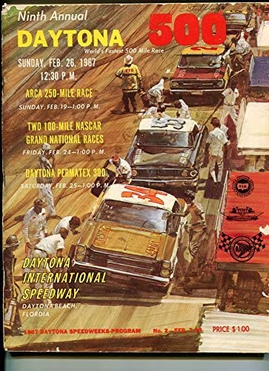Related Research Articles

DeWayne Louis "Tiny" Lund was an American stock car racer. He was a journeyman racer-for-hire in the top level NASCAR Grand National Series, running partial seasons for a number of years, including a victory in the 1963 Daytona 500. Lund saw his greatest success in the NASCAR Grand American Series, where he was the season champion in three of the four full years the series was run – Lund won 41 of the 109 Grand American events that ran.
Grand American was a NASCAR sanctioned series of pony car stock cars. The series ran from 1968 until 1972. The series was called "Grand Touring" from 1968 to 1969.

The 1967 Daytona 500 was a NASCAR Grand National Series event that was held on February 26, 1967, at Daytona International Speedway in Daytona Beach, Florida. Mario Andretti won his first NASCAR Cup Series race, and was the first foreign born, European and Italian driver to win a NASCAR Cup Series race.

The 1971 Daytona 500, the 13th running of the event, was a NASCAR Winston Cup Series race held on February 14, 1971 at Daytona International Speedway in Daytona Beach, Florida. Spanning 500 miles (800 km) on the paved oval track, it was the first Daytona 500 in the Winston Cup era of NASCAR. During this time, Richard Petty was becoming one of the winningest veterans on the NASCAR circuit.
The 1971 NASCAR Winston Cup Series season began on January 10 and ended on November 20. Richard Petty was the champion for this Winston Cup season. After 20 years of being named the NASCAR Grand National Series, R. J. Reynolds first became the primary sponsor in a decade where the growing anti-tobacco movement banned its advertisement on television and motorsports was the ideal place to place their advertisements. Through NASCAR, Winston merchandise was unveiled to live viewers of the races. This kind of merchandise would also be given out at stores that sold cigarettes in subsequent years. Race car drivers were encouraged to smoke cigarettes until the mid-2000s brought in strict drug testing policies in addition to a smoking cessation program by Nicorette, a GlaxoSmithKline brand.

The 1970 American 500 was a NASCAR Grand National Series event that was held on November 15, 1970, at North Carolina Motor Speedway in Rockingham, North Carolina. Jim Paschal qualified the #40 vehicle for Pete Hamilton.
The 1971 Miller High Life 500 was a NASCAR Winston Cup Series event that took place at Ontario Motor Speedway in Ontario, California.

The 1956 Southern 500, the seventh running of the event, was a NASCAR Grand National Series event that was held on September 3, 1956, at Darlington Raceway in Darlington, South Carolina.

The 1971 Delaware 500 was a NASCAR Winston Cup Series race that took place on October 17, 1971, at Dover Downs International Speedway.

The 1969 Texas 500 was a NASCAR Grand National Series event that was held on December 7, 1969, at Texas World Speedway in College Station, Texas.
The 1971 West Virginia 500 was a NASCAR Winston Cup Series racing event that took place on August 8, 1971, at International Raceway Park in Ona, West Virginia.
The 1971 Myers Brothers 250 was a NASCAR Winston Cup Series event that took place on August 6, 1971, at Bowman Gray Stadium in Winston-Salem, North Carolina. This race was the final NASCAR Cup Series event at Bowman Gray Stadium.
The 1971 Sandlapper 200 was a NASCAR Winston Cup Series racing event that took place on August 27, 1971, at Columbia Speedway in Columbia, South Carolina.

The 1973 Atlanta 500 was the sixth race in the NASCAR 1973 Winston Cup Series, held on April 1, 1973, at Atlanta International Raceway in Hampton, Georgia. The race took three hours and thirty-four minutes.
The 1971 Space City 300 was a NASCAR Winston Cup Series racing event that took place on June 23, 1971, at Meyer Speedway in Houston, Texas. While Houston was considered to be one of the epicenters of stock car racing during the 1950s and 1960s, the local passion for the motorsport died out starting in the 1970s.

The 1971 Dixie 500 was a NASCAR Winston Cup Series racing event that took place on August 1, 1971, at Atlanta International Raceway in Hampton, Georgia.

The 1966 Southern 500, the 17th running of the event, was a NASCAR Grand National Series event that was held on September 5, 1966, at Darlington Raceway in Darlington, South Carolina.

The 1971 Volunteer 500 was a NASCAR Winston Cup Series racing event that took place on July 11, 1971, at Bristol Motor Speedway in Bristol, Tennessee.

The 1971 National 500 was a NASCAR Winston Cup Series racing event that took place on October 10, 1971, at Charlotte Motor Speedway in Concord, North Carolina. Most of the vehicles used in the race had a rating of 427 cubic inches.

The 1968 American 500 was a NASCAR Grand National Series event that was held on October 27, 1968, at North Carolina Motor Speedway in Rockingham, North Carolina.
References
- ↑ Weather information for the 1971 Georgia 500 at the Old Farmers' Almanac
- 1 2 3 4 5 1971 Georgia 500 race information at Racing Reference
- ↑ 1971 Georgia 500 crew chiefs at Racing Reference
- ↑ 1971 Georgia 500 race information at Race Database
- ↑ Prize winnings information Archived 2014-08-08 at the Wayback Machine at Driver Averages